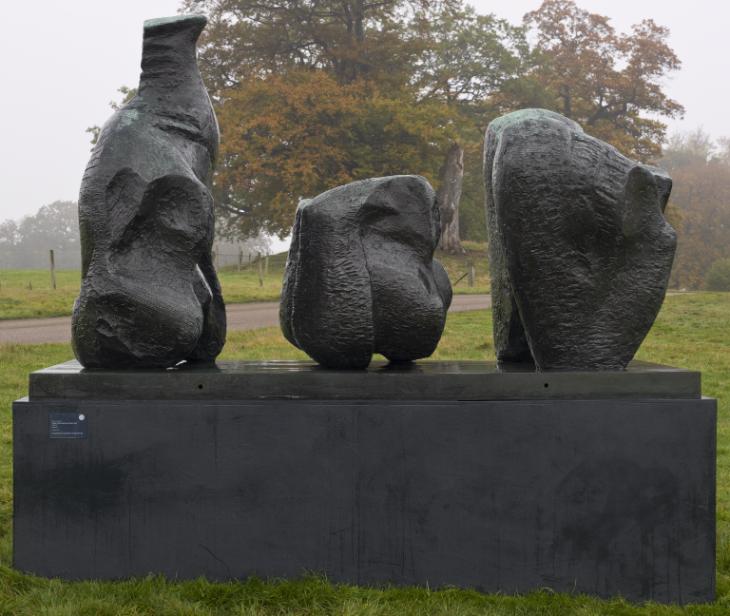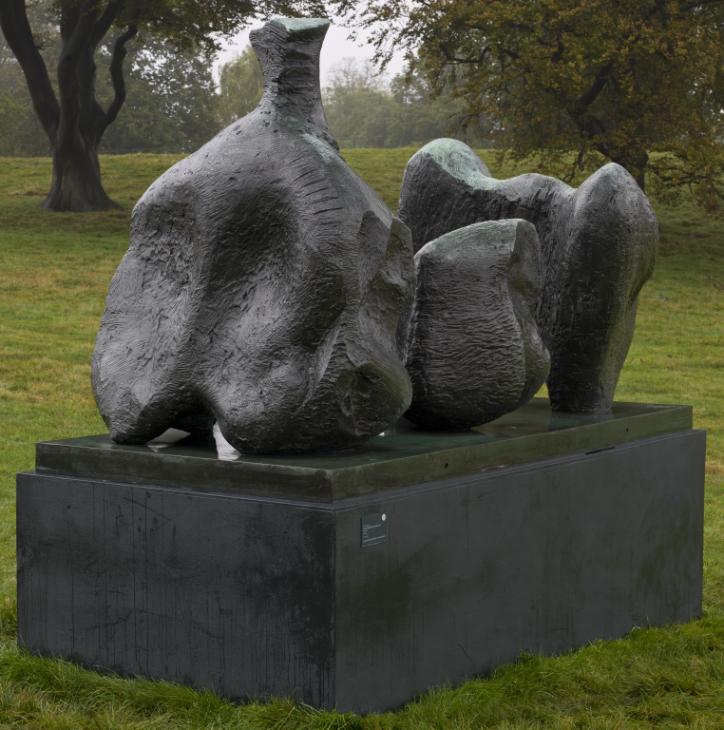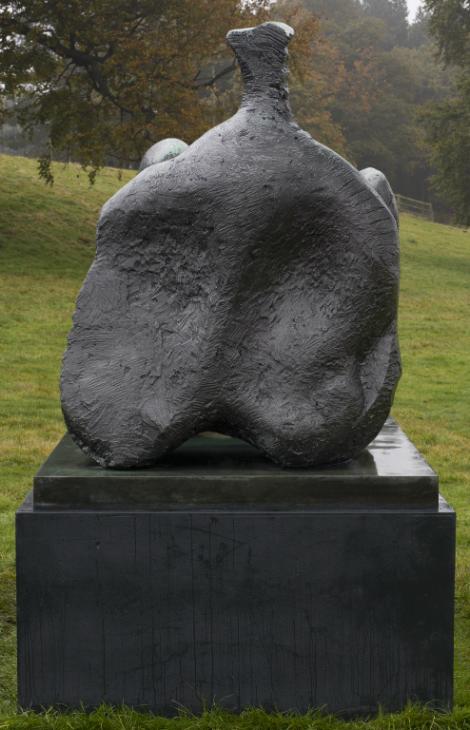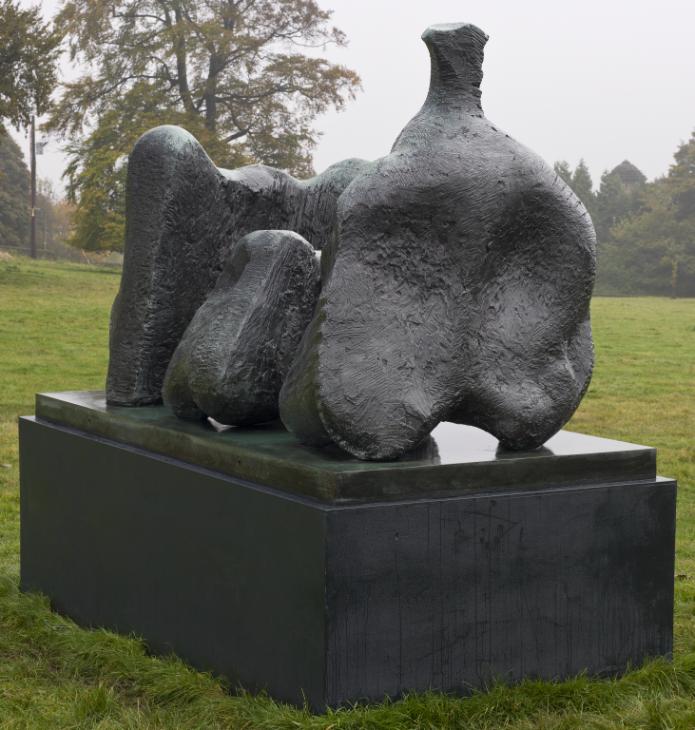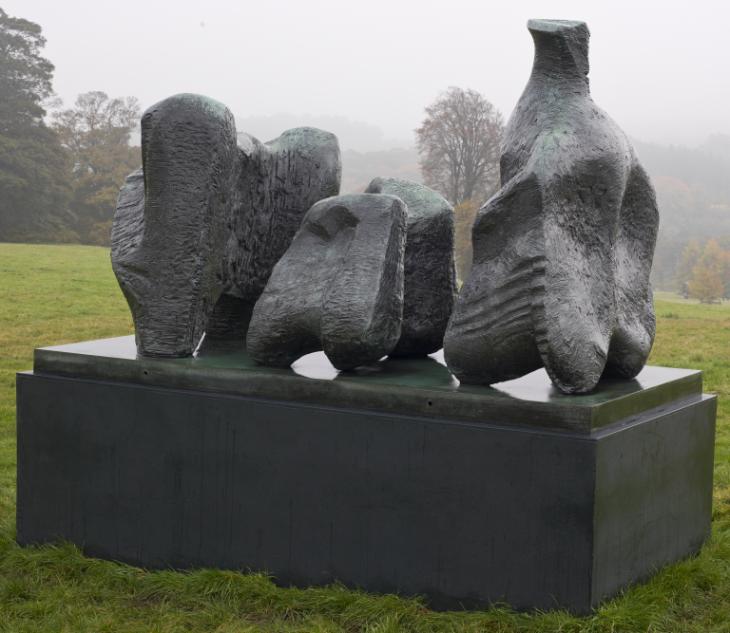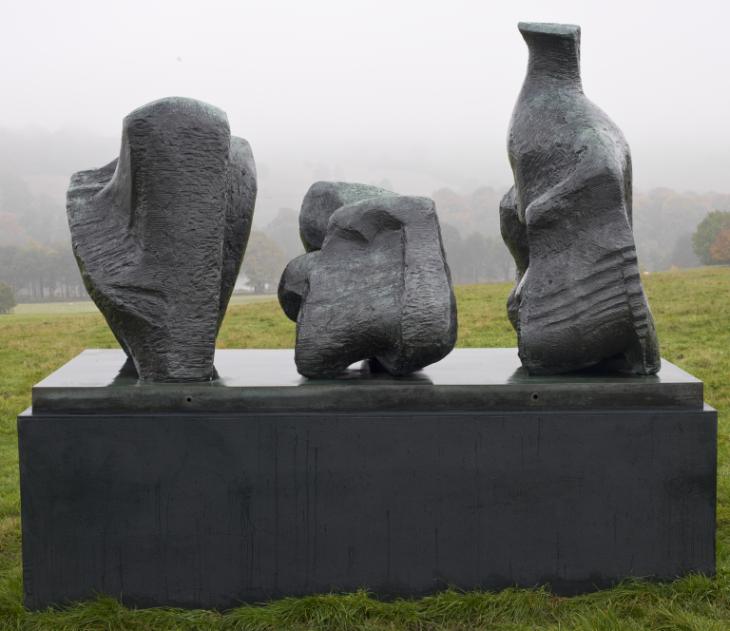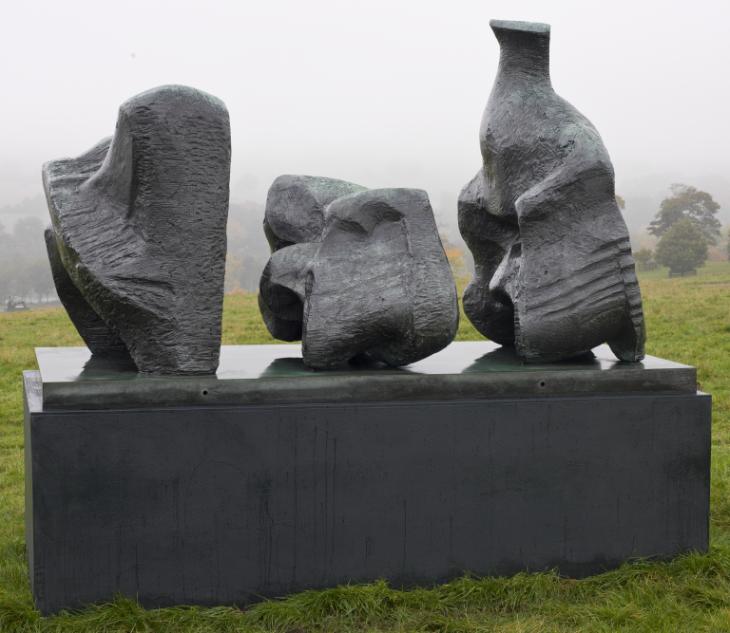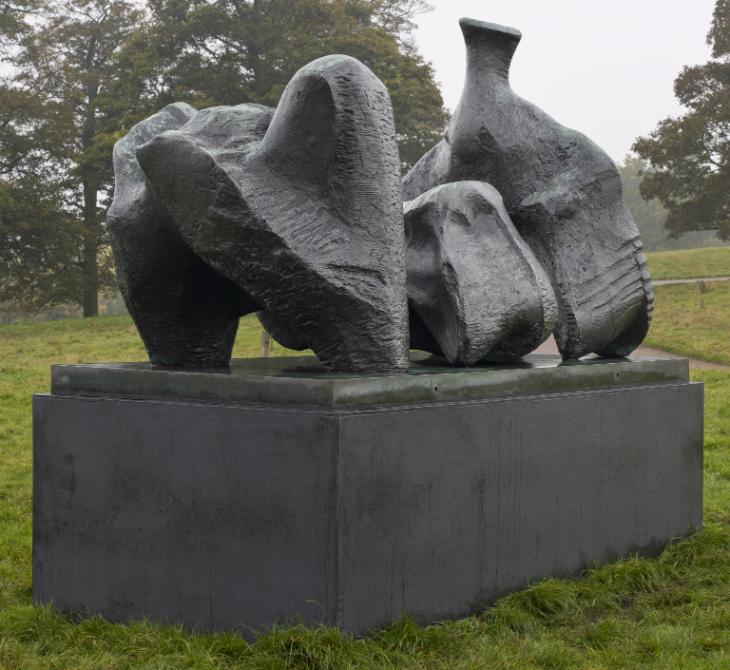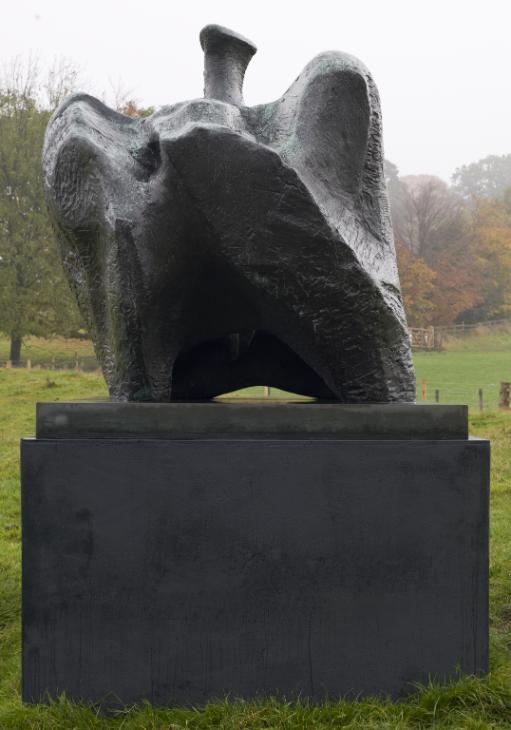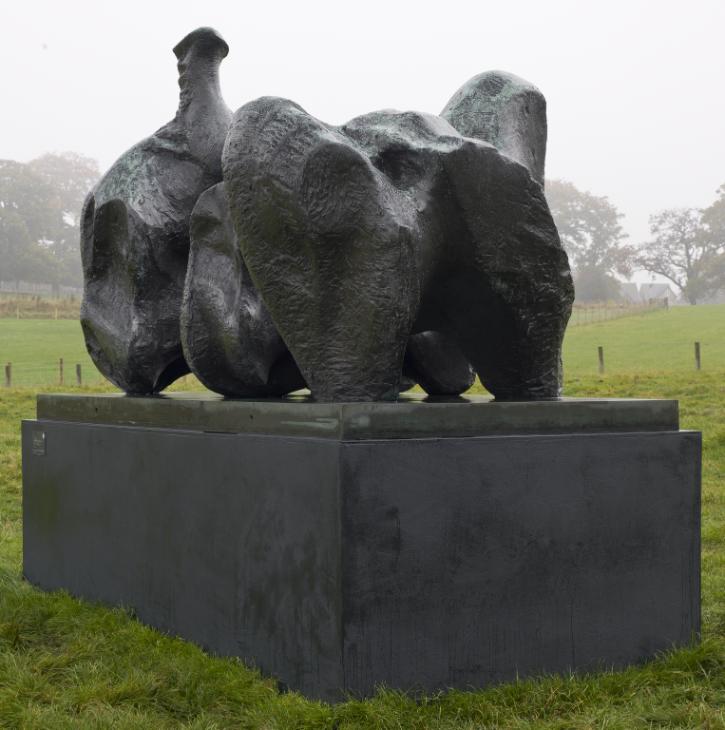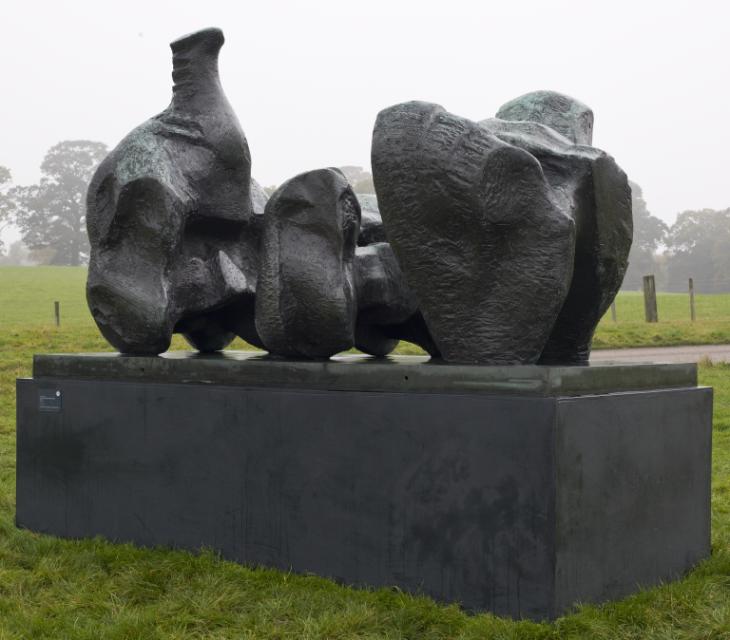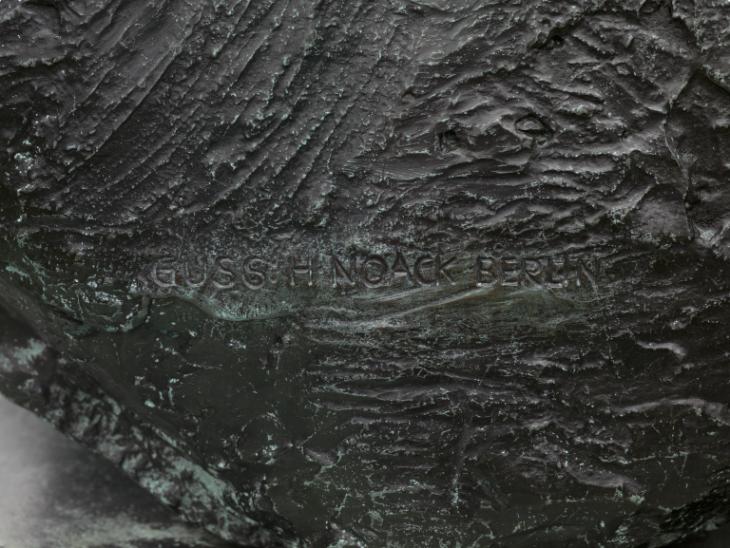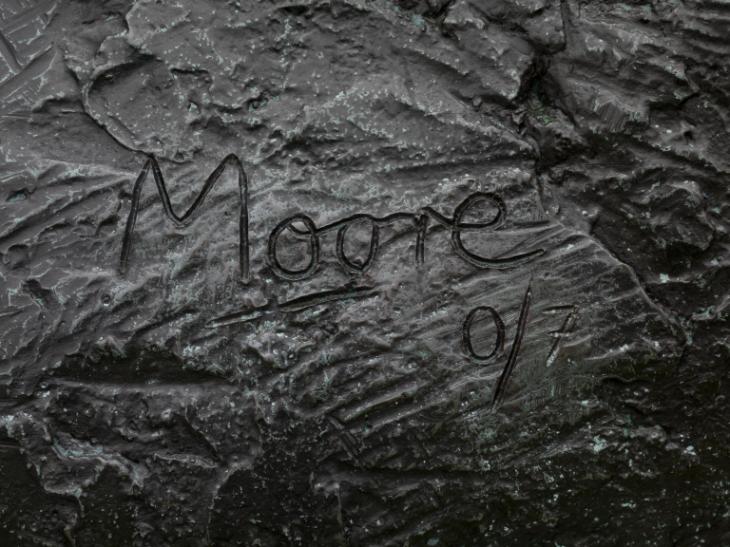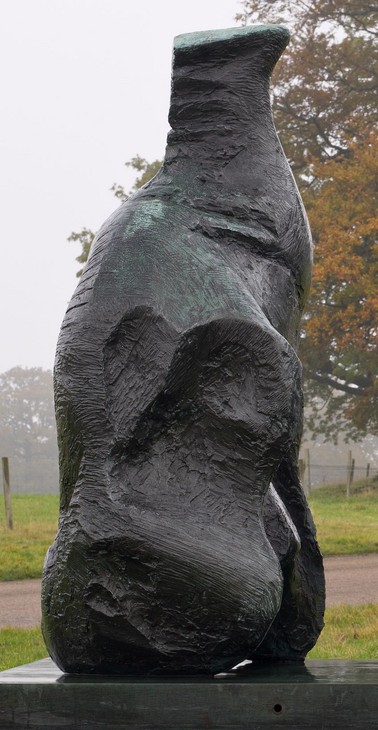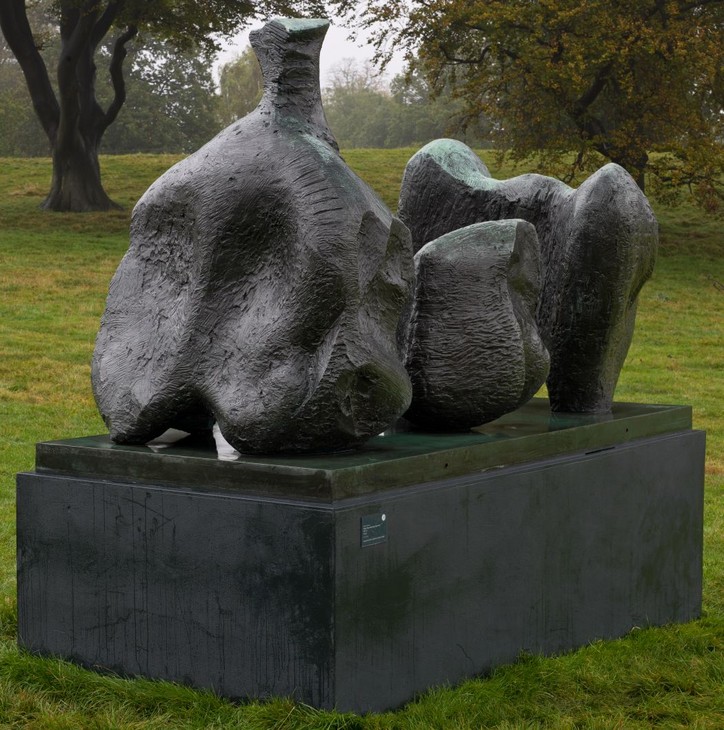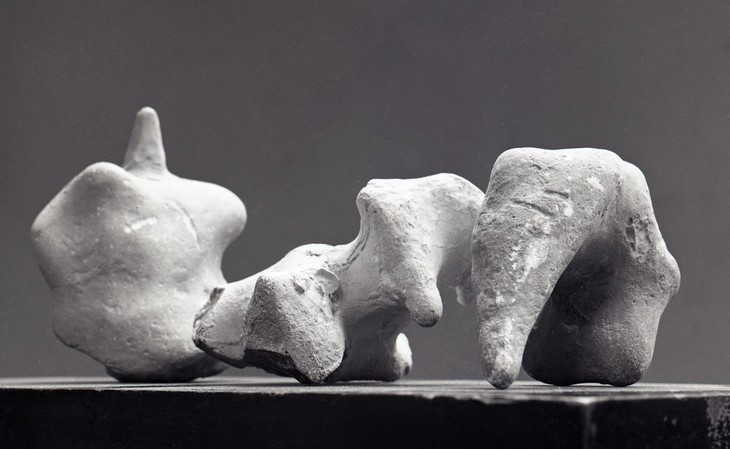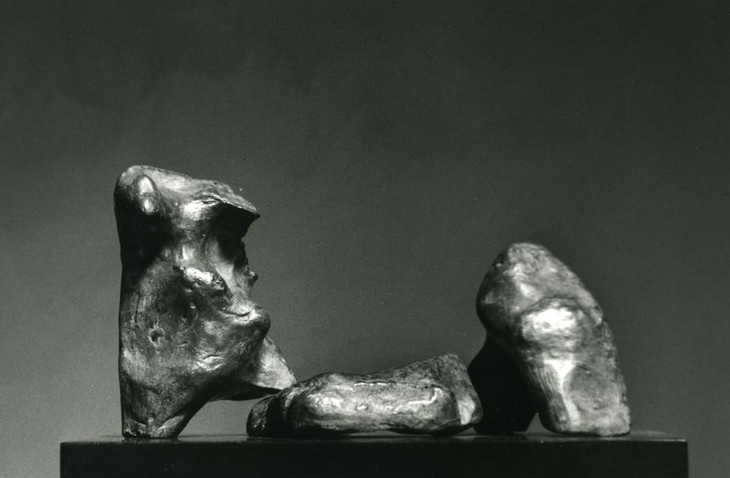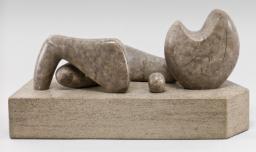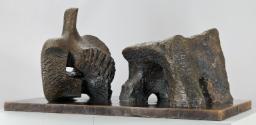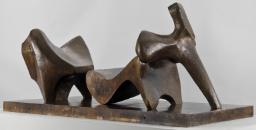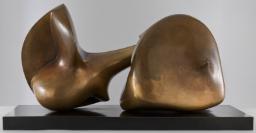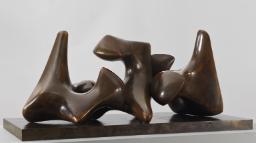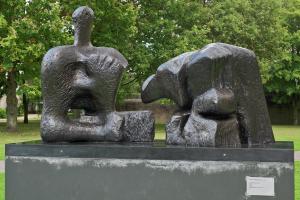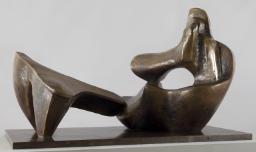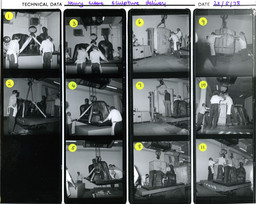Henry Moore OM, CH Three Piece Reclining Figure No.1 1961-2, cast date unknown
Image 1 of 15
-
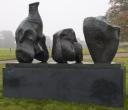 Henry Moore OM, CH, Three Piece Reclining Figure No.1 1961-2, cast date unknown© The Henry Moore Foundation. All Rights Reserved© The Henry Moore Foundation. All Rights Reserved
Henry Moore OM, CH, Three Piece Reclining Figure No.1 1961-2, cast date unknown© The Henry Moore Foundation. All Rights Reserved© The Henry Moore Foundation. All Rights Reserved -
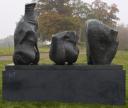 Henry Moore OM, CH, Three Piece Reclining Figure No.1 1961-2, cast date unknown© The Henry Moore Foundation. All Rights Reserved© The Henry Moore Foundation. All Rights Reserved
Henry Moore OM, CH, Three Piece Reclining Figure No.1 1961-2, cast date unknown© The Henry Moore Foundation. All Rights Reserved© The Henry Moore Foundation. All Rights Reserved -
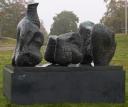 Henry Moore OM, CH, Three Piece Reclining Figure No.1 1961-2, cast date unknown© The Henry Moore Foundation. All Rights Reserved© The Henry Moore Foundation. All Rights Reserved
Henry Moore OM, CH, Three Piece Reclining Figure No.1 1961-2, cast date unknown© The Henry Moore Foundation. All Rights Reserved© The Henry Moore Foundation. All Rights Reserved -
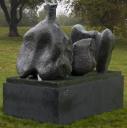 Henry Moore OM, CH, Three Piece Reclining Figure No.1 1961-2, cast date unknown© The Henry Moore Foundation. All Rights Reserved© The Henry Moore Foundation. All Rights Reserved
Henry Moore OM, CH, Three Piece Reclining Figure No.1 1961-2, cast date unknown© The Henry Moore Foundation. All Rights Reserved© The Henry Moore Foundation. All Rights Reserved -
 Henry Moore OM, CH, Three Piece Reclining Figure No.1 1961-2, cast date unknown© The Henry Moore Foundation. All Rights Reserved© The Henry Moore Foundation. All Rights Reserved
Henry Moore OM, CH, Three Piece Reclining Figure No.1 1961-2, cast date unknown© The Henry Moore Foundation. All Rights Reserved© The Henry Moore Foundation. All Rights Reserved -
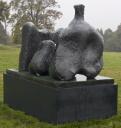 Henry Moore OM, CH, Three Piece Reclining Figure No.1 1961-2, cast date unknown© The Henry Moore Foundation. All Rights Reserved© The Henry Moore Foundation. All Rights Reserved
Henry Moore OM, CH, Three Piece Reclining Figure No.1 1961-2, cast date unknown© The Henry Moore Foundation. All Rights Reserved© The Henry Moore Foundation. All Rights Reserved -
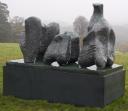 Henry Moore OM, CH, Three Piece Reclining Figure No.1 1961-2, cast date unknown© The Henry Moore Foundation. All Rights Reserved© The Henry Moore Foundation. All Rights Reserved
Henry Moore OM, CH, Three Piece Reclining Figure No.1 1961-2, cast date unknown© The Henry Moore Foundation. All Rights Reserved© The Henry Moore Foundation. All Rights Reserved -
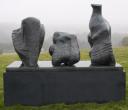 Henry Moore OM, CH, Three Piece Reclining Figure No.1 1961-2, cast date unknown© The Henry Moore Foundation. All Rights Reserved© The Henry Moore Foundation. All Rights Reserved
Henry Moore OM, CH, Three Piece Reclining Figure No.1 1961-2, cast date unknown© The Henry Moore Foundation. All Rights Reserved© The Henry Moore Foundation. All Rights Reserved -
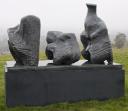 Henry Moore OM, CH, Three Piece Reclining Figure No.1 1961-2, cast date unknown© The Henry Moore Foundation. All Rights Reserved© The Henry Moore Foundation. All Rights Reserved
Henry Moore OM, CH, Three Piece Reclining Figure No.1 1961-2, cast date unknown© The Henry Moore Foundation. All Rights Reserved© The Henry Moore Foundation. All Rights Reserved -
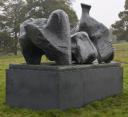 Henry Moore OM, CH, Three Piece Reclining Figure No.1 1961-2, cast date unknown© The Henry Moore Foundation. All Rights Reserved© The Henry Moore Foundation. All Rights Reserved
Henry Moore OM, CH, Three Piece Reclining Figure No.1 1961-2, cast date unknown© The Henry Moore Foundation. All Rights Reserved© The Henry Moore Foundation. All Rights Reserved -
 Henry Moore OM, CH, Three Piece Reclining Figure No.1 1961-2, cast date unknown© The Henry Moore Foundation. All Rights Reserved© The Henry Moore Foundation. All Rights Reserved
Henry Moore OM, CH, Three Piece Reclining Figure No.1 1961-2, cast date unknown© The Henry Moore Foundation. All Rights Reserved© The Henry Moore Foundation. All Rights Reserved -
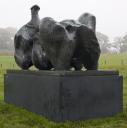 Henry Moore OM, CH, Three Piece Reclining Figure No.1 1961-2, cast date unknown© The Henry Moore Foundation. All Rights Reserved© The Henry Moore Foundation. All Rights Reserved
Henry Moore OM, CH, Three Piece Reclining Figure No.1 1961-2, cast date unknown© The Henry Moore Foundation. All Rights Reserved© The Henry Moore Foundation. All Rights Reserved -
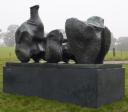 Henry Moore OM, CH, Three Piece Reclining Figure No.1 1961-2, cast date unknown© The Henry Moore Foundation. All Rights Reserved© The Henry Moore Foundation. All Rights Reserved
Henry Moore OM, CH, Three Piece Reclining Figure No.1 1961-2, cast date unknown© The Henry Moore Foundation. All Rights Reserved© The Henry Moore Foundation. All Rights Reserved -
 Henry Moore OM, CH, Three Piece Reclining Figure No.1 1961-2, cast date unknown© The Henry Moore Foundation. All Rights Reserved© The Henry Moore Foundation. All Rights Reserved
Henry Moore OM, CH, Three Piece Reclining Figure No.1 1961-2, cast date unknown© The Henry Moore Foundation. All Rights Reserved© The Henry Moore Foundation. All Rights Reserved -
 Henry Moore OM, CH, Three Piece Reclining Figure No.1 1961-2, cast date unknown© The Henry Moore Foundation. All Rights Reserved© The Henry Moore Foundation. All Rights Reserved
Henry Moore OM, CH, Three Piece Reclining Figure No.1 1961-2, cast date unknown© The Henry Moore Foundation. All Rights Reserved© The Henry Moore Foundation. All Rights Reserved
© The Henry Moore Foundation. All Rights Reserved
Henry Moore OM, CH,
Three Piece Reclining Figure No.1
1961-2, cast date unknown
© The Henry Moore Foundation. All Rights Reserved
Three Piece Reclining Figure No.1 1961–2 was the first in a series of sculptures made by Henry Moore in the early 1960s in which the artist presented the human body in three individual pieces. The forms and textures of the sculpture evoke eroded cliffs and mountains, drawing out resonances between the female body and the landscape.
Henry Moore OM, CH 1898–1986
Three Piece Reclining Figure No.1
1961–2, cast date unknown
Bronze
1693 x 2801 x 1366 mm
Inscribed ‘Moore 0/7’ and stamped ‘GUSS: H. NOACK BERLIN’ on back of torso piece
Presented by the artist 1978
Artist’s copy aside from edition of 7
T02289
Three Piece Reclining Figure No.1
1961–2, cast date unknown
Bronze
1693 x 2801 x 1366 mm
Inscribed ‘Moore 0/7’ and stamped ‘GUSS: H. NOACK BERLIN’ on back of torso piece
Presented by the artist 1978
Artist’s copy aside from edition of 7
T02289
Ownership history
Gift of the artist to his daughter Mary Moore before 1969, by whom presented to Tate in 1978 as part of the Henry Moore Gift.
Exhibition history
1968
Henry Moore, Tate Gallery, London, July–September 1968, no.122.
1970
Henry Moore Bronzes 1961–1970, Marlborough Gallery, New York, April–May 1970, no.3.
1977
Henry Moore: Sculptures et dessins, Musée de l’Orangerie des Tuileries, Paris, May–August 1977, no.100.
1978
Henry Moore: 80th Birthday Exhibition, Cartwright Hall, Bradford, April–June 1978, no.10.
1978
The Henry Moore Gift, Tate Gallery, London, June–August 1978, no number.
1987
Henry Moore and Landscape, Yorkshire Sculpture Park, West Bretton, May–August 1987, no.16.
1988
Henry Moore, Royal Academy of Arts, London, September–December 1988, no.180.
References
1963
Henry Moore: Recent Work, exhibition catalogue, Marlborough Fine Art, London 1963 (another cast reproduced on front cover).
1963
Henry Moore, exhibition catalogue, Art Center in La Jolla, La Jolla 1963 (another cast reproduced).
1964
Exhibition of Sculpture and Drawings by Henry Moore at King’s Lynn, exhibition catalogue, St Margaret’s Church, King’s Lynn 1964 (?another cast reproduced).
1965
Henry Moore, exhibition catalogue, Marlborough Fine Art, London 1965, reproduced.
1965
Herbert Read, Henry Moore: A Study of his Life and Work, London 1965, pp.229–32, reproduced pls.218, 244.
1965
Alan Bowness (ed.), Henry Moore. Volume 3: Sculpture and Drawings 1955–64, 1965, revised edn, London 1986, no.500 (?another cast reproduced pls.136–9).
1968
David Sylvester, Henry Moore, exhibition catalogue, Tate Gallery, London 1968, reproduced pl.40–1.
1968
John Russell, Henry Moore, New York 1968, pp.190–1, reproduced pl.196.
1968
John Hedgecoe (ed.), Henry Moore, London 1968, p.404, reproduced.
1968
Henry Moore, exhibition catalogue, Rijksmuseum Kröller-Müller, Otterlo 1968 (another cast reproduced, no.110).
1970
Henry Moore: Carvings 1961–70, Bronzes 1961–70, exhibition catalogue, M. Knoedler & Co., New York 1970 (another cast reproduced pp.38–9).
1973
John Russell, Henry Moore, London 1973 (?another cast reproduced pl.124).
1976
David Finn, Henry Moore: Sculpture and Environment, New York 1976 (other casts reproduced on pp.268–71, 380–5, 464–7).
1977
Henry Moore: Sculptures et dessins, exhibition catalogue, Musée de l’Orangerie des Tuileries, Paris 1977, reproduced p.80.
1977
Alan G. Wilkinson, The Drawings of Henry Moore, exhibition catalogue, Tate Gallery, London 1977, p.133, no.228, reproduced pl.62.
1978
Henry Moore: 80th Birthday Exhibition, exhibition catalogue, Cartwright Hall, Bradford 1978, reproduced.
1978
The Henry Moore Gift, exhibition catalogue, Tate Gallery, London 1978, reproduced p.47.
1979
Alan G. Wilkinson, The Moore Collection in the Art Gallery of Ontario, Toronto 1979, p.178.
1981
The Tate Gallery 1978–80: Illustrated Catalogue of Acquisitions, London 1981, pp.131–2, reproduced, p.131.
1992
Henry Moore 1898–1986, exhibition catalogue, Art Gallery of New South Wales, Sydney 1992 (?another cast reproduced p.134).
1987
Henry Moore and Landscape, exhibition catalogue, Yorkshire Sculpture Park, West Bretton 1987, reproduced p.28.
2007
Penelope Curtis, Catherine Moriarty and Joseph Giovannini (eds.), Figuring Space: Sculpture/Furniture from Mies to Moore, exhibition catalogue, Henry Moore Institute, Leeds 2007, p.12.
Technique and condition
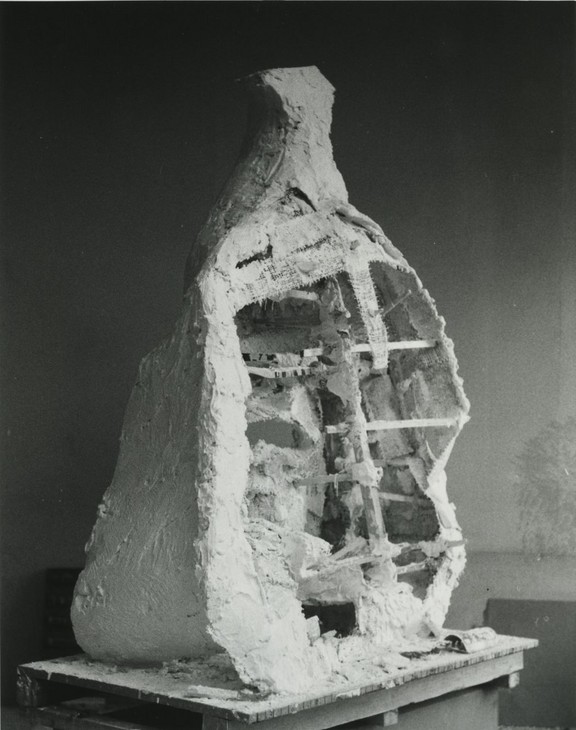
Armature for head and torso section of Three Piece Reclining Figure No.1 1961–2
The Henry Moore Foundation
© The Henry Moore Foundation. All Rights Reserved
Photo: Henry Moore Foundation Archive
Fig.1
Armature for head and torso section of Three Piece Reclining Figure No.1 1961–2
The Henry Moore Foundation
© The Henry Moore Foundation. All Rights Reserved
Photo: Henry Moore Foundation Archive
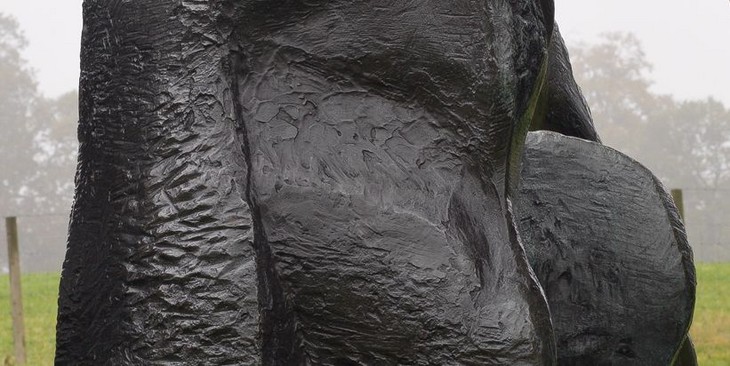
Detail of spatula marks on Three Piece Reclining Figure No.1 1961–2, cast date unknown
Tate T02289
© The Henry Moore Foundation. All Rights Reserved
Fig.2
Detail of spatula marks on Three Piece Reclining Figure No.1 1961–2, cast date unknown
Tate T02289
© The Henry Moore Foundation. All Rights Reserved
This is a three-part bronze sculpture of a reclining figure. Its three pieces are spaced at equal intervals along the length of a rectangular bronze base. The surface is dark brown-black in colour with green highlights.
This bronze would have been cast using a mould taken from a plaster original. The plaster version would have been made by applying successive layers of plaster to a supportive armature constructed from lengths of wood and scrim bandage (fig.1). The heavily textured surface of the sculpture demonstrates that Moore fully exploited the material qualities of plaster, working into it as it dried to produce a variety of surface effects. For example, some marks suggest that a spatula was used to apply wet plaster to the surface (fig.2), while striations would have been made using sharp tools or a cheese grater as the plaster began to harden (fig.3).
Once the plaster had completely set it could be chiseled like stone to produce parallel marks, as featured on the upper section of the vertically-oriented piece (fig.4), and small incisions, as seen on the lateral faces of the end section (fig.5). After the plaster sculpture was complete a mould was taken from it that was then used to make a hollow cast in bronze. This sculpture was cast by the Noack Foundry in West Berlin in an edition of seven plus one artist’s copy. It is unclear which method was used to cast this bronze but the level of detail in the surface suggests that the lost wax technique was used. The maximum size of a cast piece of bronze depends upon the size of the crucible used at the foundry as the bronze must be cast in a single pour. In practice this means that bronzes of this size are usually cast in multiple sections, which are then welded together to form the whole. The welds would have been disguised through a process called ‘chasing’. This involves filing down excess metal and using small punch tools to replicate the level and texture of the surrounding bronze. Other than this the bronze has been left as it was cast with no additional surface finishing.
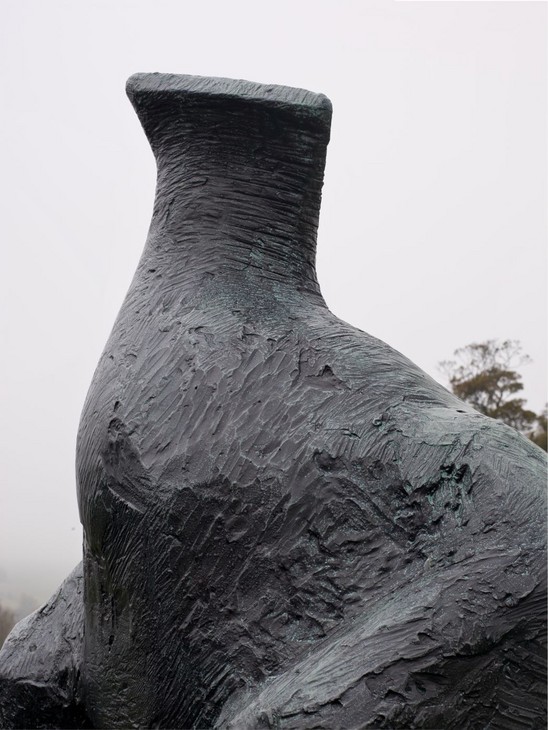
1961–2, cast date unknown Detail of chiseled area on torso piece of Three Piece Reclining Figure No.1
Tate T02289
© The Henry Moore Foundation. All Rights Reserved
Fig.4
1961–2, cast date unknown Detail of chiseled area on torso piece of Three Piece Reclining Figure No.1
Tate T02289
© The Henry Moore Foundation. All Rights Reserved
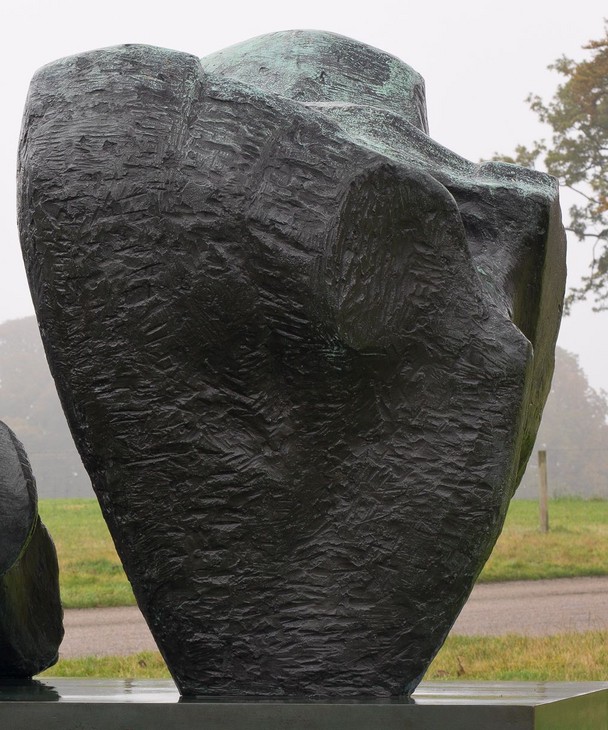
Detail of incisions on Three Piece Reclining Figure No.1 1961–2, cast date unknown
Tate T02289
© The Henry Moore Foundation. All Rights Reserved
Fig.5
Detail of incisions on Three Piece Reclining Figure No.1 1961–2, cast date unknown
Tate T02289
© The Henry Moore Foundation. All Rights Reserved
The sculpture has been given an artificial patina, which would have involved the application of chemical solutions to the surface that reacted with the metal to produce coloured compounds. It is possible that this sculpture was originally patinated a dark brown colour with mottled green colouring applied over it to highlight certain forms. However, it has now been displayed outdoors for many years and its original patina has gradually altered as a result of its exposure to the elements. Most bronze sculptures displayed outside eventually start to develop a green colour that intensifies over time due to chemical weathering. This can be seen on the base, where water has pooled over the years, and on the higher and more exposed surfaces, such as the tips of either end section (fig.6).
After patination the sculpture would have been given a protective wax coating. However, this wax deteriorates in outdoor conditions and must be replaced annually as part of an ongoing maintenance programme. This also involves washing the surface to remove dirt deposits and bird lime before the new wax is applied. A black wax was previously used to maintain the surface of this sculpture and this has darkened the patina over time.
The bronze base appears to have been sand cast and then sanded to give a smooth finish. The sculpture’s three components are fixed to the base by either two or three bolts. There are two screw-threaded holes on either side of the base which are probably intended to be used in conjunction with eye bolts. These allow lifting equipment to be attached during the installation and de-installation of the sculpture, demonstrating that Moore and his assistants were already thinking about how the piece would be installed at the fabrication stage.
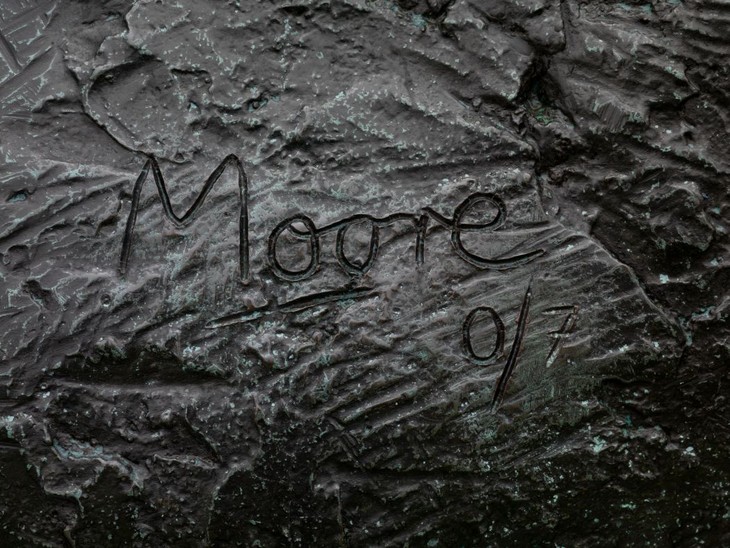
Detail of artist's signature and edition number on Three Piece Reclining Figure No.1 1961–2, cast date unknown
Tate T02289
© The Henry Moore Foundation. All Rights Reserved
Fig.7
Detail of artist's signature and edition number on Three Piece Reclining Figure No.1 1961–2, cast date unknown
Tate T02289
© The Henry Moore Foundation. All Rights Reserved
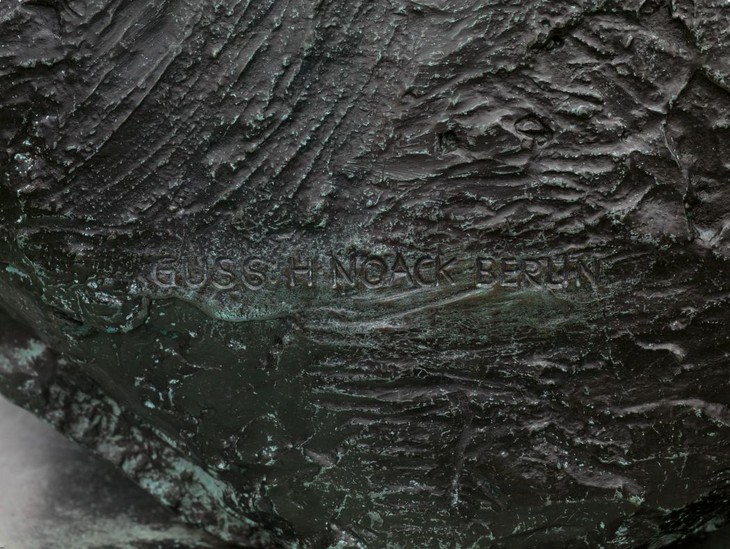
Detail of foundry stamp on Three Piece Reclining Figure No.1 1961–2, cast date unknown
Tate T02289
© The Henry Moore Foundation. All Rights Reserved
Fig.8
Detail of foundry stamp on Three Piece Reclining Figure No.1 1961–2, cast date unknown
Tate T02289
© The Henry Moore Foundation. All Rights Reserved
The artist’s signature and edition number ‘Moore 0/7’, along with the foundry mark ‘Guss: H Noack Berlin’, are visible on the tall section near the base on the right-hand side (figs.7 and 8).
Lyndsey Morgan
May 2013
How to cite
Lyndsey Morgan, 'Technique and Condition', May 2013, in Alice Correia, ‘Three Piece Reclining Figure No.1 1961–2, cast date unknown by Henry Moore OM, CH’, catalogue entry, August 2013, in Henry Moore: Sculptural Process and Public Identity, Tate Research Publication, 2015, https://wwwEntry
Three Piece Reclining Figure No.1 is one of two three-part sculptures created by Henry Moore between 1961 and 1963. The other sculpture, Three Piece Reclining Figure No.2: Bridge Prop 1963, is also held in the Tate collection (Tate T02292). In both cases the figure has been divided into three separate forms positioned on a base, one of which rises vertically to a central point and may be understood to represent a head and torso, which in turn implies that the smaller middle section represents an abdomen or hip area, while the section at the other end occupies the position of the legs.
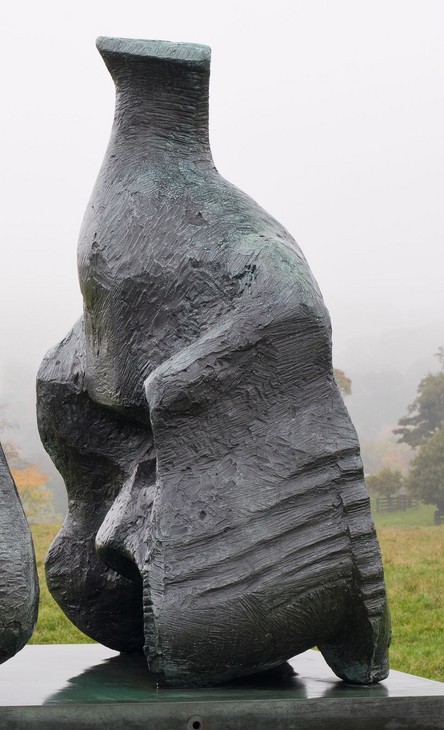
Detail of head and torso of Three Piece Reclining Figure No.1 1961–2, cast date unknown
Tate T02289
© The Henry Moore Foundation. All Rights Reserved
Fig.1
Detail of head and torso of Three Piece Reclining Figure No.1 1961–2, cast date unknown
Tate T02289
© The Henry Moore Foundation. All Rights Reserved
The middle piece is the smallest of the three segments. It also rests on the base at three points, two of which swell upwards in a similar way to the large lateral forms of the torso piece, forming what appear to be two distinct masses. One side of the right-hand form has a smooth, rounded surface while the other side appears to have been carved into, revealing bulbous, ridged surfaces. The left-hand form has one flat face and similar irregular surfaces traversing its other sides. The two forms appear to be joined only by a smaller, disk-like shape that protrudes outwards towards the leg section of the sculpture (fig.2).
This section rests on the base at two points and also appears to be comprised of two vertically orientated forms. These merge together close to the base before rising upwards and outwards to distinct, rounded peaks that might be understood to represent knees (fig.3). The side facing the middle section has a striated surface with a straight upper edge, while the opposite face projects outwards, with one large ridge emerging from the left leg near the base and tracing an upward diagonal across the section to traverse the two forms.
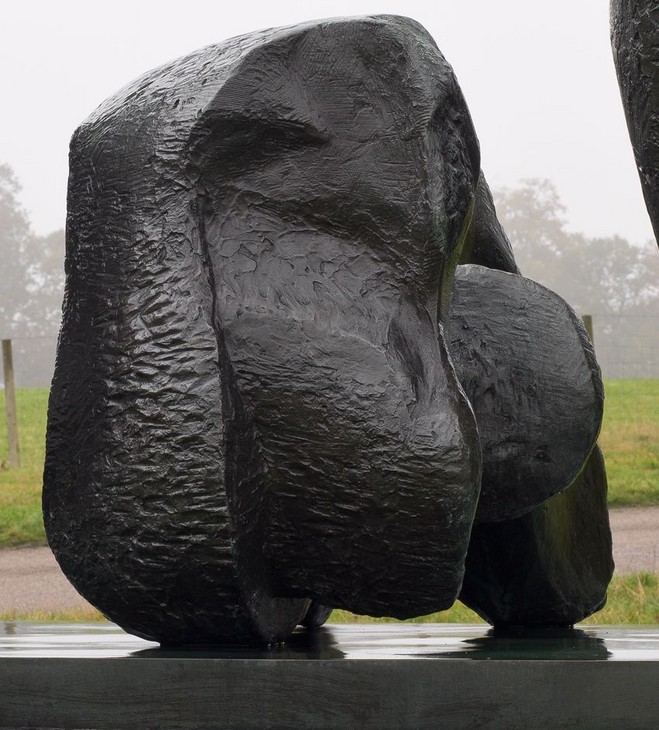
Detail of central piece of Three Piece Reclining Figure No.1 1961–2, cast date unknown
Tate T02289
© The Henry Moore Foundation. All Rights Reserved
Fig.2
Detail of central piece of Three Piece Reclining Figure No.1 1961–2, cast date unknown
Tate T02289
© The Henry Moore Foundation. All Rights Reserved
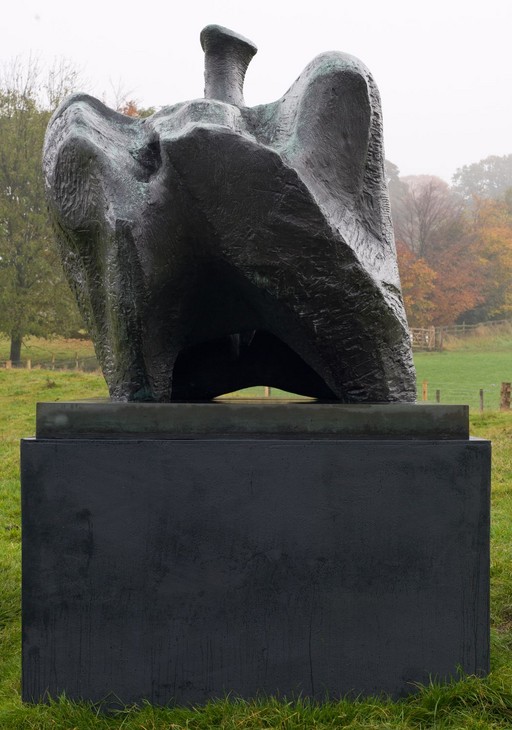
Detail of leg piece of Three Piece Reclining Figure No.1 1961–2, cast date unknown
Tate T02289
© The Henry Moore Foundation. All Rights Reserved
Fig.3
Detail of leg piece of Three Piece Reclining Figure No.1 1961–2, cast date unknown
Tate T02289
© The Henry Moore Foundation. All Rights Reserved
The surfaces of each section have been heavily worked, with grooves and channels suggesting a sense of dynamism around the sculpture. The three pieces have been set on the base at roughly equidistant intervals, although these spaces appear to narrow and close when the sculpture is viewed in the round.
From plaster to bronze
Moore developed his ideas for the three-piece sculptures with a series of small maquettes. By the early 1960s Moore had moved away from making preliminary drawings for his sculptures and had started making small three-dimensional models in plaster and other malleable materials. It is likely that he made the maquette for Three Piece Reclining Figure No.1 in the maquette studio on the grounds of his home, Hoglands, at Perry Green in Hertfordshire. This studio was lined with shelves displaying Moore’s ever growing collection of found bones, shells and pebbles, the shapes of which often served as starting points for Moore’s formal experiments in three dimensions (fig.4). In 1963 he explained to the critic David Sylvester how he worked with these natural objects:
I look at them, handle them, see them from all round, and I may press them into clay and pour plaster into that clay and get a start as a bit of plaster, which is a reproduction of the object. And then add to it, change it. In that sort of way something turns out in the end that you could never have thought of the day before.1
In the same interview Sylvester went on to ask Moore if he had used found objects in any of the multi-piece reclining figures. Moore replied:
Well, for example, in the first of the three-piece sculptures [Three Piece Reclining Figure No.1] ... one of the pieces, the middle piece was suggested by a vertebra – of I don’t know what animal it was – that I found in the garden. And the connection of one piece to another is the kind of connection that a backbone will have with one section through to the next section. But they’ve been separated. It’s as though you’ve left the slipped disc out of them, but it’s there.2
From Moore’s remarks it appears that he made the middle section of the maquette by pressing the vertebra bone into a block of clay, leaving an impression into which he could pour the plaster. After it had dried the plaster would have been removed from the clay and filed back or built up with additional plaster to enhance its forms.
Moore made numerous maquettes for three-piece sculptures between 1961 and 1963. Although some of these maquettes were cast in bronze, such as Three Piece Reclining Figure: Maquette No.1 1961 (fig.5), they were not all scaled up into full-size sculptures. Moore explained that:
Sometimes I make ten or twenty maquettes for every one that I use in a large scale – the others may get rejected. If a maquette keeps its interest enough for me to want to realise it as a full-size final work, then I might make a working model in an intermediate size, in which changes will be made before going to the real, full-sized sculpture. Changes get made at all these stages.3
The small maquette for Three Piece Reclining Figure No.1 is believed to be lost or destroyed, and was not cast into bronze. It is also unclear whether Moore created an intermediary working model for Three Piece Reclining Figure No.1. Nonetheless, he would have used a maquette or working model as the template for the full-size sculpture. By systematically charting and measuring specific points on the surface of the smaller version it could be enlarged while retaining its original proportions. This process would probably have been carried out in the White Studio in the grounds of Hoglands by one or more of Moore’s sculpture assistants, who between 1961 and 1962 included Geoffrey Greetham, Robert Holding, Clive Sheppard, Bill Smith and Isaac Witkin.

Armature for head and torso section of Three Piece Reclining Figure No.1 1961–2
The Henry Moore Foundation
© The Henry Moore Foundation. All Rights Reserved
Photo: Henry Moore Foundation Archive
Fig.6
Armature for head and torso section of Three Piece Reclining Figure No.1 1961–2
The Henry Moore Foundation
© The Henry Moore Foundation. All Rights Reserved
Photo: Henry Moore Foundation Archive
Moore’s assistants would have done much of the preliminary work on Three Piece Reclining Figure No.1. This would have included applying layers of plaster over the armature and scrim until only a short section of each of the armature’s outward-facing rods was exposed. The armature did not only serve a structural purpose but was used to facilitate the enlargement process, with the end of each rod corresponding to a point on the surface of the sculpture. Moore explained that ‘once they [the assistants] have brought the work within an inch or so of the measurements I intend it to be, I take it over, and then it becomes a thing I’m working on as it would if I had brought it to that stage myself’.4 Moore could create different types of markings, grooves and cuts depending on the varying wetness of the plaster as it dried. Moore found plaster to be a very useful material because it could be ‘both built up, as in modelling, or cut down, in the way you carve stone or wood’.5
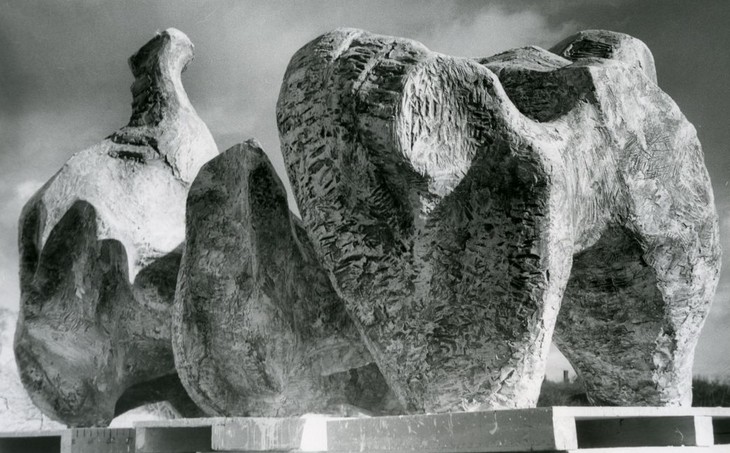
Coloured plaster version of Three Piece Reclining Figure No.1 in Moore's garden at Hoglands c.1961–2
The Henry Moore Foundation
© The Henry Moore Foundation. All Rights Reserved
Fig.7
Coloured plaster version of Three Piece Reclining Figure No.1 in Moore's garden at Hoglands c.1961–2
The Henry Moore Foundation
© The Henry Moore Foundation. All Rights Reserved
In 1962 the finished full-size plaster was sent to the Noack Foundry in West Berlin to be cast in bronze. During the 1950s and early 1960s Moore used a number of different foundries in London and Paris, but started working with Noack in 1958 following an introduction by the dealer Harry Fischer.7 By the 1950s the Noack Foundry was regarded as one of the best foundries equipped to undertake large-scale bronze castings. Moore dealt with its owner Herman Noack directly and paid for the casting of his sculptures himself. In 1967 Moore stated: ‘I use the Noack foundry for casting most of my work because in my opinion, Noack is the best bronze founder I know ... Also, the Noack foundry is reliable in all ways – in keeping to dates of delivery – and in sustaining the quality of their work’.8
The level of detail in the surface suggests that the lost wax method was most likely used to cast the sculpture in bronze. Furthermore, in a letter dated 15 May 1962 Moore explained to the Canadian painter Cleeve Horne that his cast of Three Piece Reclining Figure No.1 had been delayed because ‘parts of it were only in the wax stage’.9 This technique would have required the foundry to carve up the plaster into sections and create moulds from each piece. The inside of each mould would then be ‘greased’ with a releasing agent before molten wax was poured into it. Once the wax had hardened it could be released from the mould, forming an exact replica of the sculpture in wax. The wax would then be encased in a hard refractory material, placed in a kiln and heated until it melted. Channels within the casing would allow the wax to drain away and, once empty, the cavity was filled with molten bronze. Once the bronze had hardened its casing was removed, revealing a section of sculpture. After every piece of the sculpture had been cast in this way they would be welded together. Finally, the casting seams would have been filed down until the joints between each section of the cast were practically imperceptible.
The mould could be used to create multiple wax replicas, and the casting process was repeated for each sculpture in the edition. After being reassembled at the foundry bronze sculptures were often returned to Moore so that he could inspect the quality of the casting and make decisions about patination. A patina is the surface colour of a sculpture and is usually achieved by applying chemical solutions to the pre-heated bronze surface. In 1963 Moore asserted ‘I always patinate bronze myself’, going on to explain that since he had conceived the sculpture it would be unlikely that anyone else would be able to replicate the exact colour he wanted.10 However, Noack is known to have patinated a certain number of Moore’s sculptures at the foundry. But even in these instances Moore was still able to adjust the patina when the sculpture was returned to the studio.
Bronze is an alloy of copper and tin and the patina of bronze sculptures displayed outdoors changes over time due to reactions between the metal and chemicals in the air. The cast of Three Piece Reclining Figure No.1 held in the collection of the Meadows Museum at the Southern Methodist University in Dallas is displayed outdoors and has developed a green patina as the copper content of the bronze has oxidised. Tate’s cast is a fairly uniform dark brown colour, which is maintained by regular waxing and cleaning. Nonetheless, the patina has changed over time due to periods of exposure to the weather and patches of green colour can be identified, particularly on the sculpture’s high points (fig.8).
Sources and development
The main source of information about Moore’s three-piece figures is his 1963 BBC Radio interview with David Sylvester, extracts from which were printed in the weekly arts journal the Listener. When asked about the differences between the three-piece reclining figures and the two-piece figures that he created between 1959 and 1962, such as Two Piece Reclining Figure No.2 1960 (Tate T00395), Moore explained:
The two-piece sculptures pose a problem like the kind of relationship between two people. And it’s very different once you divide a thing into three: then you have two ends and a middle. In the two-piece you have just the head end and the body end or the head end and the leg end, but once you get the three-piece you have the middle and the two ends, and this became something that I wanted to do, having done the two-piece. I tried several little ideas before this one and what led me to this solution was finding a little piece of bone that was the middle of a vertebra, and I realised then that perhaps the connection through, of one piece to another, could have gone on and made a four- or five-piece, like a snake with its vertebrae right through from one end to the other. But three is enough to make the difference from two. That is what one tried to make: it is a connecting-piece carrying through from one end to the other like you might have with a snake.11
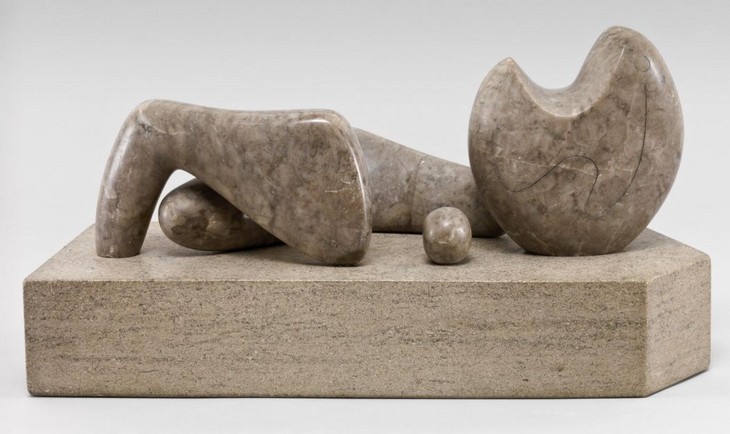
Henry Moore
Four-Piece Composition: Reclining Figure 1934
Cumberland alabaster on a Purbeck marble base
175 x 457 x 203 mm
Tate T02054
© The Henry Moore Foundation. All Rights Reserved
Fig.9
Henry Moore
Four-Piece Composition: Reclining Figure 1934
Tate T02054
© The Henry Moore Foundation. All Rights Reserved
In the same interview in 1968 Moore remarked that in 1933–4 ‘I began separating forms from each other in order to be able to relate space and form together’.14 This explanation may also be applicable to his multi-part sculptures of the 1960s, which also comprise several distinct forms composed in a way that activates the space between them. During a conversation with Moore on 12 December 1980 Morphet recorded that ‘about both the two-and three-piece reclining figures, Moore was at pains to stress his concern with the interdependence of space and proportion’.15 In this interpretation the gaps between the three sections of Three Piece Reclining Figure No.1 become active spaces in which the relationships between parts are continually reimagined as the sculpture is experienced in the round.
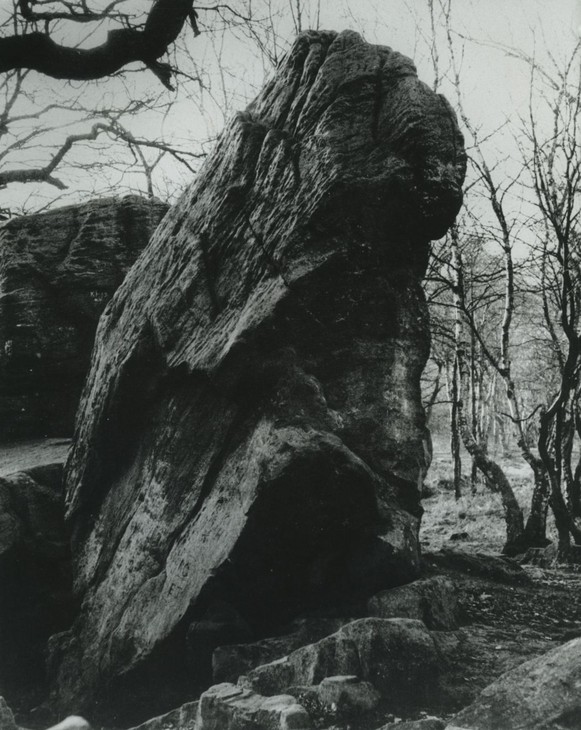
John Hedgecoe
Adel Crag
© The Henry Moore Foundation. All Rights Reserved
Fig.10
John Hedgecoe
Adel Crag
© The Henry Moore Foundation. All Rights Reserved
In 1973 the critic John Russell expanded upon these parallels, claiming that the form of Three Piece Reclining Figure No.1 is ‘closely related to cliff-face and mountain-side’.20 He went on to suggest that, while Moore’s works of the 1930s reimagine the figure to look like stones or boulders, the multi-part works of 1959–61 appear to take boulders and relate them to the human body. Russell saw this logic as cumulative, so that by the time Moore created Three Piece Reclining Figure No.1 ‘he was beginning to make the point that boulders look like boulders: very imposing and finely-worked boulders, but boulders none the less’.21 The critic Robert Melville had given a similar interpretation in 1970, suggesting that in his two- and three-piece sculptures Moore was not transforming the female body into a landscape, but rather presenting landscapes which incidentally recalled the female form: ‘They are images of rocky landscapes which bear an “accidental” resemblance to woman.’22
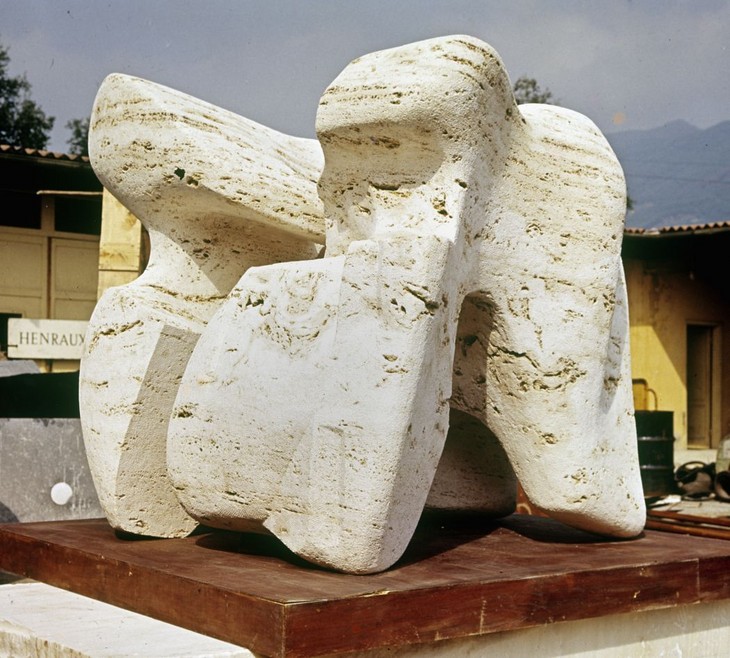
Henry Moore
Stone Memorial 1961–9
Travertine marble
National Gallery of Art, Washington D.C.
© The Henry Moore Foundation. All Rights Reserved
Fig.11
Henry Moore
Stone Memorial 1961–9
National Gallery of Art, Washington D.C.
© The Henry Moore Foundation. All Rights Reserved
Critical reception
An example of Three Piece Reclining Figure No.1 was displayed in a two-person exhibition at the Marlborough Fine Art’s New London Gallery in July 1963. In this show nineteen recent sculptures by Moore were exhibited alongside thirteen paintings by Francis Bacon. The works Moore included in the show were generally reviewed favourably, with David Thompson writing in the Times:
Moore has never looked grander, more inventive, more the absolute master of his means of expression. Bone-shapes are now almost the whole source of his formal vocabulary, but they are no longer as literally transcribed (they are, that is to say, no longer as baldly bony) as when he started on them a couple of years ago ... As a more than worthy successor to his famous ‘two-piece’ reclining figures, he now shows one in three sections based on the shapes of vertebrae. Whereas the two-piece figures suggested sea-caves and marine headlands, the pieces wrested apart as by a convulsion of the elements, the new figure is more like the tumbled, wind-eroded boulders of some desert range of hills, brooded over by a head like a watching vulture’s.24
The curator Bryan Robertson was similarly positive towards Moore’s new sculptures, suggesting in the Listener that the new works demonstrated an inventive departure from the more elegant and coherent reclining women that dominated Moore’s work of the 1950s. Robertson asserted:
The new sculpture of Henry Moore confirms a feeling that after marking time for a while in the nineteen-fifties he has moved through to an intensity of feeling and constructive energy which has demanded and found a considerable extension of sculptural language. The knife-edge forms, the three-piece reclining figure ... the locking piece ... are all brilliant and forceful inventions. The essence of Moore’s work is always to be found in his grimmest or most ferocious sculpture; his matronly figures and other sweeter preoccupations lack the conviction and the formal power of his darker side.25
Like Thompson, the critic Eric Newton, writing in the Guardian, noted the influence of rocks, boulders and mountainous landscapes upon Moore’s formal language. He too acknowledged the awesome nature of Moore’s work, and concluded his review by noting, ‘it is remarkable that an artist who has made so many creative discoveries and added so much to the sum total of sculptural rhythms in our own century, should be able to continue on his voyages of discovery without seeming to repeat his past successes or enlarge on his own inventions’.26 Similarly, the critic Nigel Gosling reflected in the Observer that ‘at 65, Moore might be expected to be slowing down in invention, but here he seems to be as fertile as ever. He not only solves problems – we all know he can do that. He finds fascinating problems to solve’.27 However, Gosling also highlighted shortcomings with Three Piece Reclining Figure No.1:
The largest exhibit here is one of his familiar reclining women. But he recently – and splendidly – explored the possibilities of splitting this into two pieces. Now he has split it into three. It is a noble great thing, yet it is not quite so interesting as its predecessor. The vertebra-like middle section is so inevitable that one can almost imagine it being removed altogether without altering the composition, and parts of the surface have been too arbitrarily textured.28
The Henry Moore Gift
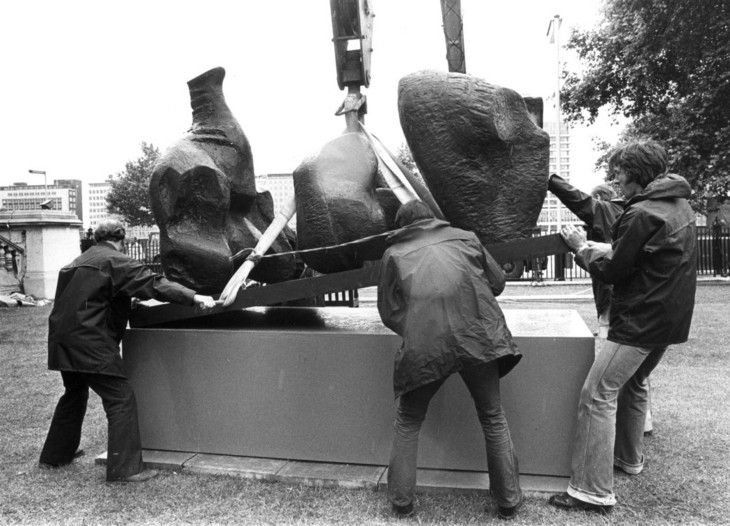
Three Piece Reclining Figure No.1 1961–2, cast date unknown, being installed on the Tate lawn in 1978
Tate T02289
© The Henry Moore Foundation. All Rights Reserved
Fig.12
Three Piece Reclining Figure No.1 1961–2, cast date unknown, being installed on the Tate lawn in 1978
Tate T02289
© The Henry Moore Foundation. All Rights Reserved

Detail of artist's signature and edition number on Three Piece Reclining Figure No.1 1961–2, cast date unknown
Tate T02289
© The Henry Moore Foundation. All Rights Reserved
Fig.13
Detail of artist's signature and edition number on Three Piece Reclining Figure No.1 1961–2, cast date unknown
Tate T02289
© The Henry Moore Foundation. All Rights Reserved
Three Piece Reclining Figure No.1 was cast in an edition of seven plus one artist’s copy. The version in Tate’s collection is stamped with the artist’s signature and the number ‘0/7’ (fig.13), indicating that this cast was originally the artist’s copy. The full-size plaster is held in the collection of the Art Gallery of Ontario, Toronto, and the other bronze casts can be found in the Kreeger Museum, Washington; Rochester Institute of Technology, New York; Meadows Museum at Southern Methodist University, Dallas; and CIBC Tower, Montreal. The remaining casts are believed to be held in private collections.
Alice Correia
August 2013
Notes
Henry Moore cited in ‘Henry Moore Talking to David Sylvester’, 7 June 1963, transcript of Third Programme, BBC Radio, broadcast 14 July 1963, p.18, Tate Archive TGA 200816. (An edited version of this interview was published in the Listener, 29 August 1963, pp.305–7.)
Henry Moore cited in Donald Hall, ‘Henry Moore: An Interview by Donald Hall’, Horizon, November 1960, reprinted in Alan Wilkinson (ed.), Henry Moore: Writings and Conversations, Aldershot 2002, p.226.
Moore cited in ‘Henry Moore Talking to David Sylvester’, 7 June 1963, p.10, Tate Archive TGA 200816.
Henry Moore, letter to Cleeve Horne, 15 May 1962, Henry Moore Foundation Archive. Horne was acting as an intermediary for the CIBC in Montreal, Quebec, which subsequently acquired a cast of the sculpture directly from the artist.
[Richard Morphet], ‘T.2054 Henry Moore: Four-Piece Composition 1934’, The Tate Gallery 1976–8: Illustrated Catalogue of Acquisitions, London 1979, p.121.
Alan G. Wilkinson, Henry Moore Remembered: The Collection at the Art Gallery of Ontario in Toronto, Toronto 1987, p.202.
Henry Moore cited in John Hedgecoe (ed.), Henry Moore: My Ideas, Inspiration and Life as an Artist, London 1986, p.35.
In March 1978 Moore wrote to Tate Director Norman Reid informing him that he had to reduce the number of works in the Gift from thirty-eight to thirty-six because he had since discovered that some of the works that were initially reserved for the Tate actually belonged to his daughter Mary and so were not his to give: ‘The sculptures I am giving to the Tate number 36 in all. At some previous time the number had been given as 38, but when it came to finalise the list, it was discovered that four sculptures ... had already been given by me to my daughter, Mary, at a date previous to 1969. I mentioned this to my daughter and she very generously agreed to give up two of the works, Glenkiln Cross and Three Piece Reclining Figure No.1, to make my Tate gift a fuller representation of my work.’ Henry Moore, letter to Norman Reid, 16 March 1978, Tate Archive, TG4/6/10/4.
Related essays
- Henry Moore and the Values of Business Alex J. Taylor
- Scale at Any Size: Henry Moore and Scaling Up Rachel Wells
- Henry Moore: The Plasters Anita Feldman
- Henry Moore's Approach to Bronze Lyndsey Morgan and Rozemarijn van der Molen
Related catalogue entries
Related material
-
Photographic contact sheet
How to cite
Alice Correia, ‘Three Piece Reclining Figure No.1 1961–2, cast date unknown by Henry Moore OM, CH’, catalogue entry, August 2013, in Henry Moore: Sculptural Process and Public Identity, Tate Research Publication, 2015, https://www


